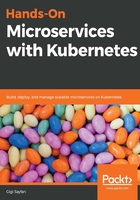
Playing with your cluster
Minikube is running, so let's have some fun. Your kubectl is going to serve you well in this section. Let's start by examining our node:
$ kubectl get nodes
NAME STATUS ROLES AGE VERSION
minikube Ready master 4m v1.13.0
Your cluster already has some pods and services running. It turns out that Kubernetes is dogfooding and many of its own services are plain services and pods. But, those pods and services run in namespaces. Here are all the namespaces:
$ kubectl get ns
NAME STATUS AGE
default Active 18m
kube-public Active 18m
kube-system Active 18m
To see all the services in all the namespaces, you can use the --all-namespaces flag:
$ kubectl get svc --all-namespaces
NAMESPACE NAME TYPE CLUSTER-IP EXTERNAL-IP PORT(S) AGE
default kubernetes ClusterIP 10.96.0.1 <none> 443/TCP 19m
kube-system kube-dns ClusterIP 10.96.0.10 <none> 53/UDP,53/TCP 19m
kube-system kubernetes-dashboard ClusterIP 10.111.39.46 <none> 80/TCP 18m
The Kubernetes API server, itself, is running as a service in the default namespace and then we have kube-dns and the kubernetes-dashboard running in the kube-system namespace.
To explore the dashboard, you can run the dedicated Minikube command, minikube dashboard. You can also use kubectl, which is more universal and will work on any Kubernetes cluster:
$ kubectl port-forward deployment/kubernetes-dashboard 9090
Then, browse to http://localhost:9090 and you will see the following dashboard:
